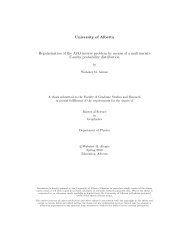Soner Bekleric Title of Thesis: Nonlinear Prediction via Volterra Ser
Soner Bekleric Title of Thesis: Nonlinear Prediction via Volterra Ser
Soner Bekleric Title of Thesis: Nonlinear Prediction via Volterra Ser
Create successful ePaper yourself
Turn your PDF publications into a flip-book with our unique Google optimized e-Paper software.
3.1. NONLINEAR PROCESSES VIA THE VOLTERRA SERIES 28<br />
ries is equivalent to the convolution representation <strong>of</strong> a system. The last expression<br />
can be represented in a more general form as follows:<br />
y(t) =<br />
∞<br />
k=1<br />
<br />
1 ∞ ∞<br />
dσ1 · · ·<br />
k! −∞<br />
−∞<br />
k<br />
dσkhk(σ1, σ2 . . . , σk) x(t − σp) (3.2)<br />
p=1<br />
where, again, x(t) is the input, y(t) is the output <strong>of</strong> the system. This functional<br />
form was first studied by the Italian mathematician Vito <strong>Volterra</strong>, so is known as<br />
the <strong>Volterra</strong> series, and the functions hk(σ1, . . . , σk) are known as <strong>Volterra</strong> kernels<br />
<strong>of</strong> the system. Norbert Wiener (1942) first applied these series to the study <strong>of</strong><br />
nonlinear systems. As seen in equation (3.2) the <strong>Volterra</strong> series can be regarded as<br />
a nonlinear extension <strong>of</strong> the classical linear convolution.<br />
H<br />
x(t) y(t)<br />
H<br />
H<br />
1<br />
2<br />
3<br />
Figure 3.1: Schematic representation <strong>of</strong> a system characterized by a third-order<br />
<strong>Volterra</strong> series. Modified from Schetzen (1980). H1, H2 and H3 represent the<br />
impulse responses <strong>of</strong> the first, second and third-order <strong>Volterra</strong> kernels, respectively.<br />
Figure 3.1 illustrates a schematic representation <strong>of</strong> a system is characterized by<br />
a third-order <strong>Volterra</strong> series.<br />
3.1.2 Frequency domain representation <strong>of</strong> <strong>Volterra</strong> kernels<br />
The representation <strong>of</strong> a <strong>Volterra</strong> kernel in the Fourier domain is given by<br />
+









